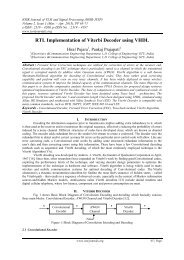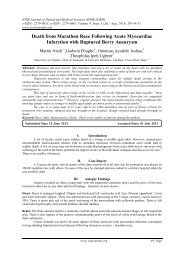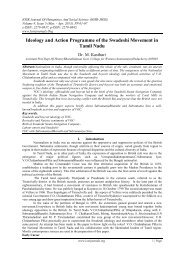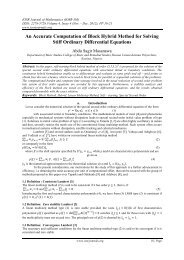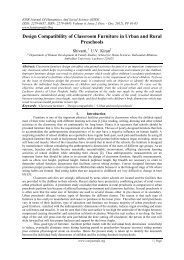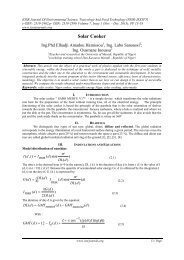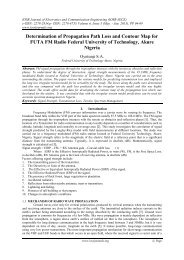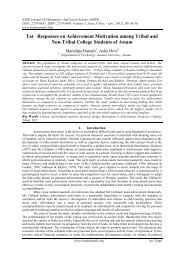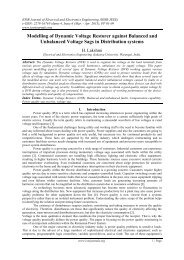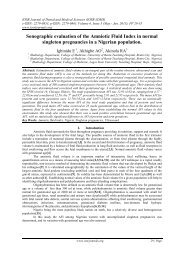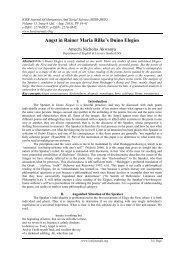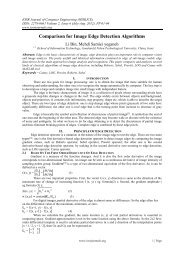Initial Conquest of India by Turks and Their Slaves - IOSR
Initial Conquest of India by Turks and Their Slaves - IOSR
Initial Conquest of India by Turks and Their Slaves - IOSR
Create successful ePaper yourself
Turn your PDF publications into a flip-book with our unique Google optimized e-Paper software.
<strong>IOSR</strong> Journal Of Humanities And Social Science (JHSS)<br />
ISSN: 2279-0837, ISBN: 2279-0845. Volume 5, Issue 4 (Nov. - Dec. 2012), PP 34-39<br />
Www.Iosrjournals.Org<br />
The Influential Effect <strong>of</strong> Folk Arts - Pot Chitra in Present Trend<br />
<strong>of</strong> Fashion in Bangladesh: An Overview<br />
1 Najmul Kadir Kaikobad, 2 Helena Nazneen Zobaida, 3 Md Zafar Alam Bhuiyan,<br />
4 Mahmudur Rahman, 5 S. M. Ashiqur Rahman,<br />
1<br />
Assistant Dean & Center Head, Shanto-Mariam University <strong>of</strong> Creative Technology, City campus, Lalmatia,<br />
Dhaka, Bangladesh<br />
2 Coordinator & Lecturer, Fundamental <strong>of</strong> Art & Design, Shanto-Mariam University <strong>of</strong> Creative Technology,<br />
City campus, Lalmatia, Dhaka, Bangladesh<br />
3 Assistant Proctor & Lecturer <strong>of</strong> Fashion Design, Shanto-Mariam University <strong>of</strong> Creative Technology, City<br />
campus, Lalmatia, Dhaka, Bangladesh<br />
4 Lecturer, Fundamental <strong>of</strong> Art & Design, Shanto-Mariam University <strong>of</strong> Creative Technology, City campus,<br />
Lalmatia, Dhaka, Bangladesh<br />
5 Senior Motion Graphics Designer,Desh TV, Dhaka, Bangladesh<br />
Abstract: Recognizing Pot Chitra as formalized folklore, the word Pot Chitra has been analyzed. The customs<br />
<strong>of</strong> picture painting <strong>and</strong> the making <strong>of</strong> elongated Pot Chitra have been discussed. Amongst the thous<strong>and</strong>s <strong>of</strong><br />
materials or objects in the folk arts it is not difficult to underst<strong>and</strong> the worldly characteristics. Sometimes, the<br />
divine philosophies <strong>and</strong> the realistic philosophies have been the guide amongst these topics. The formation <strong>of</strong><br />
art <strong>and</strong> its rhythmic outlines were attained <strong>by</strong> the artist‟s aesthetic mind. Therefore, the mass, volume <strong>and</strong> types<br />
<strong>of</strong> art-forms can be found, such as, pottery, carpentry <strong>and</strong> engraving, architecture, metal crafts, shell crafting,<br />
ivory crafting, mask making etc. Similarly in the graffiti, quilt-making, mat-crafting etc, <strong>and</strong> even in the<br />
ornament craft, the aesthetic rhythm <strong>of</strong> art is evident. Folk art, the integrated part <strong>of</strong> Bengal, displays a rich<br />
vocabulary <strong>of</strong> motifs. These motifs are deeply rooted in strong religious beliefs <strong>and</strong> underlay a strong<br />
symbolism. These motifs signify the desire for “self expression” <strong>and</strong> manifestation <strong>of</strong> the artisan‟s aspirations.<br />
I. Introduction<br />
Fashion in Bangladesh is growing <strong>and</strong> becoming increasingly fruitful in its endeavors. More <strong>and</strong> more<br />
designers are popping up, making an effort to bring the industry up to international st<strong>and</strong>ards. In the process,<br />
however, it is sad to say that, in many cases, the glamour <strong>and</strong> glitter <strong>of</strong> other, more advanced industries around<br />
the world, such as <strong>India</strong>, influence our fusionist designers as so much that we <strong>of</strong>ten lose our own sense <strong>of</strong><br />
fashion <strong>and</strong> merely follow the trends set <strong>by</strong> others. Being <strong>India</strong> as a neighboring country is hard for<br />
Bangladesh's self image. As it is, we tend to measure our success according to the success <strong>of</strong> the <strong>India</strong>ns, never<br />
taking into account that they are far older as a nation. In addition, we look to <strong>India</strong> for trend in many different<br />
aspects <strong>of</strong> our daily lives, be it arts, music, entertainment or even fashion. Let's not be denied the fact that many<br />
Bangladeshi women <strong>and</strong> girls or boys are quite happy trying to look like the latest Bollywood actress or actor. In<br />
fact, how many times have one walked into a sharee store <strong>and</strong> had a chumki-ala, shaded sharee thrown in one<br />
direction, claiming it was the latest thing in <strong>India</strong>, even naming it after the movies in which beautiful doll-like<br />
actresses with impossibly thin figures wear. We constantly fall into the trap <strong>of</strong> idealizing everything the <strong>India</strong>ns<br />
do. Those who can afford to do so always go to <strong>India</strong> for wedding shopping, rather than doing any major<br />
shopping in Bangladesh. And already there are a h<strong>and</strong>ful <strong>of</strong> big stores in the Gulshan area which strongly look<br />
like shops in <strong>India</strong>. Rather than taking pride in what sets us apart from other nation: our culture, our traditions<br />
<strong>and</strong> our heritage. We spend all our time copying <strong>India</strong>n trends while we slowly lose our own sense <strong>of</strong> style.<br />
Gone are the days <strong>of</strong> Tangail H<strong>and</strong>loom <strong>and</strong> Jamdanis, because Bollywood has not thought them worthy <strong>of</strong><br />
glamorizing. Our designers have no choice but to keep bringing in more <strong>India</strong>n trends in order to keep their<br />
clients happy.<br />
Our analysis is about Bangladeshi fashion design deals only with the surface such as block, batik,<br />
embroidery, h<strong>and</strong> paint etc. These aspects are very strong in the fashion industry, but unfortunately surface work<br />
is only a part <strong>of</strong> designing. There are many different aspects that are not touched upon as much as they should<br />
be here, such as fittings, patterns or even forecasting <strong>and</strong> also the relevance <strong>of</strong> what works with our<br />
surroundings. For example, many people don't distinguish that the colors <strong>and</strong> fabrics that are relevant for<br />
summers; for an example mainly light colors <strong>and</strong> fabrics that breathe - are not necessarily relevant for other<br />
seasons, such as winter, in which designers can use darker colors <strong>and</strong> more heavy fabrics. Using h<strong>and</strong>loom<br />
fabrics that are both 'colorful <strong>and</strong> cultural,' we feel that we can create design such as depict the innocent <strong>and</strong><br />
pure beauty <strong>of</strong> the indigenous community <strong>of</strong> Bangladesh.<br />
www.iosrjournals.org<br />
34 | Page



